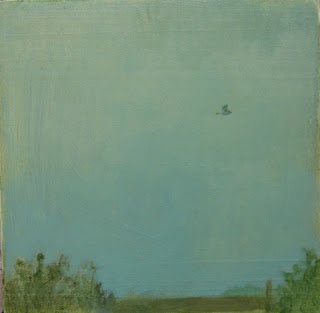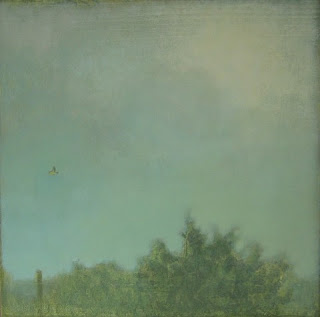+Medium+Web+view.jpg) Wingohocking (bluejay), 2008, by Lynne Campbell
Wingohocking (bluejay), 2008, by Lynne CampbellThe art of this painter, with which I have been familiar for many years now, is perhaps hardest to write of, because I have seen all of it, and because I am so close to the artist. I must be careful not to read into the paintings things I know about the painter, and yet, to explain the artist is sometimes a help in appreciating her art.
While still a student at the Pennsylvania Academy of the Fine Arts, Lynne began an interest in the square format, not that she hadn’t created in another format, but it was this shape she began to explore as a window. Notice that the equality of the sides is a very even and calming equilibrium between the vertical and horizontal. It resolves at the outset what classical composition must struggle to obtain. Unlike classical composition, which balances horizontal and vertical by increasing the meaning of the vertical, Lynne’s composition begins in a state of harmony. The implied vertical distance, supplied by classical art’s belief in the divine (think of John the Baptist’s finger pointing upward in Leonardo DaVinci’s painting), or in mannerism’s exaggeration of the vertical (as in El Greco’s figures, streaming heavenward), here is made equal to the horizontal. Such paintings could only be created in an age of post enlightenment; it sees into the world according to nature’s equidistance from us.
While still a student at the Pennsylvania Academy of the Fine Arts, Lynne began an interest in the square format, not that she hadn’t created in another format, but it was this shape she began to explore as a window. Notice that the equality of the sides is a very even and calming equilibrium between the vertical and horizontal. It resolves at the outset what classical composition must struggle to obtain. Unlike classical composition, which balances horizontal and vertical by increasing the meaning of the vertical, Lynne’s composition begins in a state of harmony. The implied vertical distance, supplied by classical art’s belief in the divine (think of John the Baptist’s finger pointing upward in Leonardo DaVinci’s painting), or in mannerism’s exaggeration of the vertical (as in El Greco’s figures, streaming heavenward), here is made equal to the horizontal. Such paintings could only be created in an age of post enlightenment; it sees into the world according to nature’s equidistance from us.

Sighting (silently), 1993, by Lynne Campbell
In her early paintings in this format, Lynne Campbell used the occurrence of manmade structures in the natural or wild landscape as evidence of the mathematical sublime – a term De Chirico used to describe the metaphysical effect of certain large manmade structures in the world and in his paintings. Whatever marks time, or endures time, would give him that effect, thus the clock’s presiding over statues or classical ruins, with a train crossing the horizon far off. Time and timelessness keep track of each other, emphasize each other, in those paintings.
 untitled, 1995, by Lynne Campbell
untitled, 1995, by Lynne Campbell
Entry, 1996, by Lynne Campbell
For Lynne Campbell, who especially loved De Chirico’s paintings then, the mathematical sublime was visible in oil tanks, or water towers. The water towers became an important motif, after the interest in oil tanks seen in refineries. These early compositions had high horizons, and the sources of oil and water seemed to require that. They were studies of the earth as a source of one or another elemental fluid.
 Return, 1997, by Lynne Campbell
Return, 1997, by Lynne CampbellWith the water towers, an eventual shift took place, and the horizon moved to the bottom of the composition. Water’s other source, the divinity of air and weather, became acknowledged, and it is about that time that she and I became bird watchers. With that interest a new motif became her obsession, the sighting of a bird.
And now I will explain how like Agnes Martin these square, abstracted skies, become. They contain the slenderest piece of horizon. There is the equilibrium of the format, and then there is the placement of the bird in that context. The way the space is divided, the way the line of flight enters, or predicts its passage, all balance in a remarkable way. The object of each of these compositions, whether they include energy or the stasis of humidity, is an extraordinary serenity.
And now I will explain how like Agnes Martin these square, abstracted skies, become. They contain the slenderest piece of horizon. There is the equilibrium of the format, and then there is the placement of the bird in that context. The way the space is divided, the way the line of flight enters, or predicts its passage, all balance in a remarkable way. The object of each of these compositions, whether they include energy or the stasis of humidity, is an extraordinary serenity.
 Late, 2004, by Lynne Campbell
Late, 2004, by Lynne CampbellThe serenity of nature is not what she implies in these paintings, but the serenity of the onlooker. She is showing a certain viewpoint, in which we are at the moment between dwelling on a sky-filled landscape and noticing a passing bird. The sense of the cosmos, of the allness of the sky has us absorbed, and the bird noticed is placed in an incredible fit within the viewer’s universe. It is not locked-in so much as released-into. The environment and the inhabitant are as one, imbued with the spirit of each other. It is in this way that the older classical vertical direction has been made imminent. One can see spirit right there before oneself. Centuries of science and understanding have brought us to the potency of the present. These are paintings possible after Emily Dickenson, and after the general awakening about the fragility of the environment. They are a discovery coincident with that which holds that life evolves from its surroundings, that context matters, and that passage moves through the creating air of our life.
+Medium+Web+view.jpg) Wingohocking (goldfinch), 2008, by Lynne Campbell
Wingohocking (goldfinch), 2008, by Lynne CampbellObservations like these are timeless because we can understand they were always true, even if they now seem recently new, beginning the wave of the present age. While in the city, the birds were part of the urban environment, passing over rooftops with the complete ease of belonging. Now, though still in the city, they constitute a series named for a street that in Lenape means “a good place to plant.”
Edward Sozanski has termed them visual haiku, admitting their spare means and profound effect. As poetry does, they awaken us to a sense of being, and a state of awakened bliss. Though many are summer or winter visions, they grant that first truth of seeing the spirit of life, the spirit most of us assume each spring when we wake up to the sky and the weather in a state of bliss. If a Buddha were to come as the face of nature, he would make us compassionate in the way these paintings of our nature make us feel.
